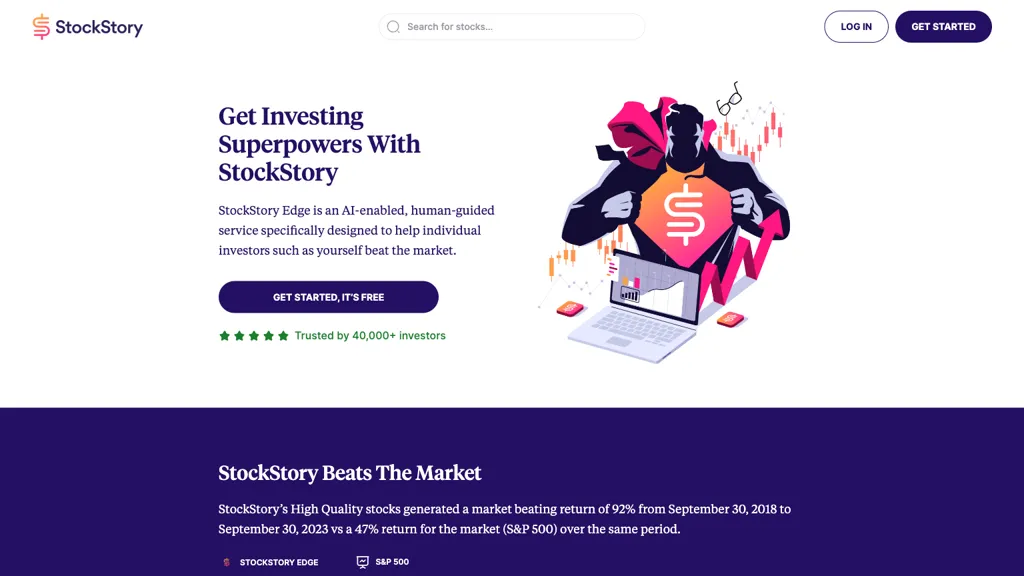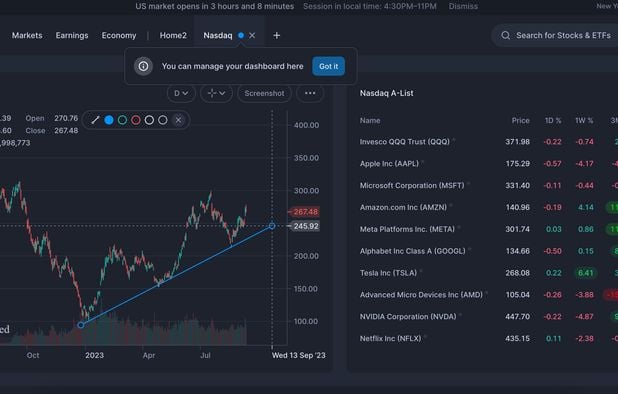20 Excellent Facts For Selecting AI Stock Trading Platform Websites
20 Excellent Facts For Selecting AI Stock Trading Platform Websites
Blog Article
Top 10 Tips For Evaluating The Accuracy And Performance Of Ai Stock Predicting/Analyzing Trading Platforms
To ensure that you are using a platform capable of providing accurate and reliable forecasts and insights, it is important to test the accuracy and efficiency of AI platform for predicting stocks and analyzing them. Here are ten top suggestions to evaluate these platforms.
1. Backtesting Results
What to look for: Make sure the platform you choose to use allows users to run back-tests to determine how accurate their predictions were using previous data.
Why it is Important by comparison of the AI model's predictions with actual historical outcomes, backtesting validates its accuracy.
Look for platforms which allow you to customise backtesting parameters such as duration and asset types.
2. Real-time Performance Tracking
What to Look for: Find out the performance of the platform compared with the current market conditions.
Why it matters It is because the platform's real-time performance is a better indicator of its performance instead of relying solely on past backtesting.
TIP: Make use of an account demo or free trial to track real-time predictions and then compare them with actual market fluctuations.
3. Prediction Error Metrics
What to Look Out For to determine the accuracy of predictions by measuring metrics like the Mean Absolute Error(MAE) or the Root-Mean Squared Error(RMSE) or Rsquared.
Why It's Important: These measures provide a quantifiable measure of the degree to which predictions are in line with the actual outcomes.
Platforms that openly share metrics are usually more transparent.
4. Win Rate and Success Ratio
What to look for the platform's win rate (percentage for correct predictions) and the success rate (profitability based upon the predictions).
Why is it Important: High win rates and success ratios show greater predictive accuracy and potential profits.
Be aware that no system can be perfect.
5. Benchmarking against Market Indices
What to look for: Compare the platform's predictions and performances to important market indexes, like S&P 500 or NASDAQ.
What it does: It helps determine whether the platform is performing better or worse than the market as a whole.
Look for outperformance that is consistent over time, and not just in the short-term.
6. Consistency on Market Conditions
What to look out for: Determine how the platform performs in different market conditions (bull or bear markets, high volatility).
Why it matters: A robust platform must be able to perform in all market conditions and not only when the market is favorable.
Tips: Use the platform in volatile times or downturns in the market.
7. Transparency in Methodology
What to Watch Out For Know AI models, algorithms, and techniques (e.g., neural networks, reinforcement learning).
Why it is Important Transparency in methodology lets you assess the reliability and scientific rigor of the platform.
TIP: Beware of platforms that use "black box" models that do not explain how they generate predictions.
8. Users Reviews and Independent Testing
What to look out for: Read reviews from users and verify independent testing.
Why It Matters Reviews and testing conducted by independent experts offer unbiased information about the platform's accuracy and performance.
Tips: Look into forums such as Reddit, copyright, or financial blogs to see what people have experienced.
9. Risk-Adjusted Returns
What to look for How to evaluate the performance of your platform using risk-adjusted measures such as the Sharpe Ratio or Sortino Ratio.
Why It Matters The metrics are based on the amount of risk is taken to produce returns. This provides the most complete view of the performance.
Sharpe Ratio: If it's high (e.g. > 1) This indicates higher returns when risk is considered.
10. Long-term Track Record
What to look out for: Determine the platform's overall performance over time (e.g. 3 to 5 years).
What's important: Long term results are a far more reliable indicator of reliability as compared to short-term results.
Do not use platforms that show only some short-term results or only show a few instances of success.
Bonus tip: Sign up for an account with a demo version
Try out the platform's real-time predictions by using a demo or trial account without risking your money. This will allow you to assess the accuracy and efficiency.
By following these tips, you can thoroughly assess the performance and accuracy of AI stock predicting and analyzing platforms, ensuring you choose one that matches your trading goals and the risk you are willing to accept. Be aware that no platform can be trusted, therefore combining AI insights and your own research along with the predictions made by the platform is typically the best choice. Have a look at the best ai stock for site tips including ai stocks, ai for stock predictions, trading ai, ai for investment, ai investing app, ai for stock predictions, ai investing app, using ai to trade stocks, best ai trading app, ai stock and more.
Top 10 Ways To Evaluate The Speed And Latency Of Ai Stock Trading Platforms
The speed and latency of the trading platform are crucial factors to consider, especially when it comes to active traders as well as high-frequency investors and algorithmic traders. A delay of just milliseconds can negatively impact profitability and trade execution. Here are the top 10 tips for measuring the speed of the platform.
1. Real-Time data feeds can be used to determine the quality of your real-time data
Data delivery time: The platform must provide real-time, accurate data within the shortest amount of time (e.g. with sub-millisecond delays).
Data source closeness: Determine the location of servers close to major exchanges.
Data compression: Determine whether the platform utilizes effective data compression techniques to speed up the delivery of data.
2. Test Trade Speed of Execution
The time it takes to process your order is the time of your order that will be processed and completed by the platform.
Direct market access (DMA): Ensure that the exchange platform provides DMA that lets orders be sent directly to the exchange without intermediaries.
Check the execution reports to see whether they contain timestamps for order confirmation, fill, and submission.
3. Review the responsiveness of the Platform
User interface (UI), speed: Test the platform’s response time to your inputs.
Updates to charts - Check that the charts are updated in real time and without delay.
Performance of mobile apps If you are using a mobile app, make sure that it's just as fast as your desktop version.
4. Look for infrastructure that is low-latency.
Servers' location The platform is using servers with low latency that are located close to exchanges and financial hubs.
Co-location Services: Check if the platform allows co-location. This allows you to save your trading algorithms on servers that are close to the Exchange.
High-speed Networks: Check the use of a fiber-optic high-speed network or other technologies with low latency.
5. Evaluation of Simulation and Backtesting Speed
Find out how fast your platform is able to process and analyze the historical data.
Platform latency must be minimal enough to permit real-time simulations of trades.
Parallel processing: Find out if the platform utilizes distributed computing or parallel processing to speed up complex calculations.
6. Examine the API Latency
API response time determining how quickly the platform’s API responds (e.g. getting market data or placing an order).
Rate limits: Verify that the API has adequate rate limits to avoid delays during high-frequency trading.
WebSocket: Check whether the platform is compatible with WebSocket protocols that allow streaming of data in real-time with low latency.
7. Test Platform Stability under Load
High-volume trading: To test the platform’s ability to respond and stability, you can simulate high-volume scenarios.
Market volatility Test the platform in times of extreme market volatility to see if it is able to handle the rapid price movements.
Test your strategies for stress: See whether the platform has tools for stress testing your strategies in extreme circumstances.
8. Study the network and its connectivity
Speed requirements for internet: Check that your internet connection meets the recommended speed of your platform to ensure optimal performance.
Redundant connections: Check to see if there are redundant connections.
VPN latency: If you are using a VPN platform, check whether the latency is high and if there are alternatives.
9. Look for Speed Optimization Features
Pre-trade analyses The platform must provide pre-trade analyses to optimize the speed of execution and routing of orders.
Smart order routing (SOR) is also referred to as smart order routing, is a method to determine the fastest and the most efficient execution locations.
Monitoring latency Make sure your platform lets you analyse and track your latency live.
User Feedback and Review Benchmarks
User reviews: Read user feedback to determine the platform's performance in terms of speed and latency.
Benchmarks from third-party sources: Search for independent benchmarks and reviews which compare the performance of the platform against its rivals.
Testimonials and case studies Find out whether there are any cases that show the effectiveness of the platform's low-latency capabilities.
Bonus Tips
Trial period: Take advantage of an unpaid trial or demo to test the platform's speed and latency in actual situations.
Customer Support: Check whether the platform provides assistance with issues related to latency, or optimization.
Hardware requirements. Check to see whether a particular platform requires special hardware (e.g. a high-performance computer) to function at optimum speed.
Following these tips can aid in assessing the performance of AI trading platforms that predict/analyze the prices of stocks. It will allow you to select a platform for trading that is the most suitable for the requirements of your trading and eliminates any delays. A low latency, particularly for high-frequency and algorithmic trading, is essential. Even the smallest delays can significantly affect profitability. See the top rated how to use ai for copyright trading info for website recommendations including how to use ai for stock trading, ai stock analysis, ai stock analysis, ai stock prediction, invest ai, ai stock price prediction, best ai for stock trading, ai share trading, best stock prediction website, ai in stock market and more.